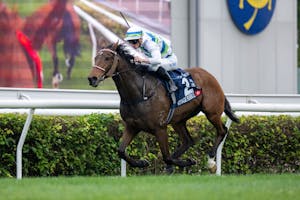Horse Sense: Understanding Takeout

A lot of people new to horse racing believe that a racetrack works like the average Vegas casino (think MGM, Caesar’s Palace, Red Rocks, Orleans, or Golden Nugget). But that’s not the case at all.
Unlike a casino where the house makes money if you lose, the goal of a racetrack is to run races on which wagers are made by people called handicappers or horseplayers. That’s it.
That doesn’t mean the track does this for free. Each track holds out a certain percentage of every pool wagered into before paying out (ie: Win, Place, Show, Exacta, Quinella, Trifecta, Superfecta, Double, Pick 3-4-5-6, etc). This is called “takeout.”
Each track sets their takeout rates and often there are different levels for the individual pools. According to data from HANA, takeout ranges from 14% on a Canterbury Pick 3 or Pick 4 to a to 31% on a Penn National Trifecta. The average Win/Place/Show takeout is 17%, 23% for single race exotics, and 22% for multi-race wagers; this makes the average national takeout for all wagers 22%.
So for every $1 wagered, $.22 goes to the house. So where does the rest of the 78% go?
This is what makes American pari-mutuel betting so interesting. There is no “house” in Thoroughbred wagering. The odds that you see on the toteboard or the wagerpad are based on the potential win payoff for each individual horse. While there is the morning line – set by the track oddsmaker as a suggestion for what he thinks the public will do – the actual odds at post time (when the pools close) is based on the concept of Your Money v. Mine. The track has zero interest in how you bet as long as they get their takeout; that said: they would prefer you to make a sizeable wager, since that would increase the total of their take.
Let’s look at a very simple example:
Three horseplayers like three different horses in a single race. One person wagers $50 on HorseA, another $50 on HorseB, and the third $100 on HorseC.
If the takeout is the national average 17% on Win wagers, then figure…
$200 x .17 = $34 goes to the track as takeout
$200 x .83 = $166 is divided up amongst the horseplayers who bet on the winning horse
It’s important to understand takeout because it effects the betting odds. As Jeff Platt, the president of HANA, explains:
Unlike a casino where the house makes money if you lose, the goal of a racetrack is to run races on which wagers are made by people called handicappers or horseplayers. That’s it.
That doesn’t mean the track does this for free. Each track holds out a certain percentage of every pool wagered into before paying out (ie: Win, Place, Show, Exacta, Quinella, Trifecta, Superfecta, Double, Pick 3-4-5-6, etc). This is called “takeout.”
Each track sets their takeout rates and often there are different levels for the individual pools. According to data from HANA, takeout ranges from 14% on a Canterbury Pick 3 or Pick 4 to a to 31% on a Penn National Trifecta. The average Win/Place/Show takeout is 17%, 23% for single race exotics, and 22% for multi-race wagers; this makes the average national takeout for all wagers 22%.
So for every $1 wagered, $.22 goes to the house. So where does the rest of the 78% go?
This is what makes American pari-mutuel betting so interesting. There is no “house” in Thoroughbred wagering. The odds that you see on the toteboard or the wagerpad are based on the potential win payoff for each individual horse. While there is the morning line – set by the track oddsmaker as a suggestion for what he thinks the public will do – the actual odds at post time (when the pools close) is based on the concept of Your Money v. Mine. The track has zero interest in how you bet as long as they get their takeout; that said: they would prefer you to make a sizeable wager, since that would increase the total of their take.
Let’s look at a very simple example:
Three horseplayers like three different horses in a single race. One person wagers $50 on HorseA, another $50 on HorseB, and the third $100 on HorseC.
If the takeout is the national average 17% on Win wagers, then figure…
$200 x .17 = $34 goes to the track as takeout
$200 x .83 = $166 is divided up amongst the horseplayers who bet on the winning horse
It’s important to understand takeout because it effects the betting odds. As Jeff Platt, the president of HANA, explains:
As horseplayers, we bet value. We make a careful analysis of factors we see as relevant and weigh our analysis against the odds. If we think value exists we bet. If we think value is absent we pass.
Lower takeout translates into more situations worthy of our betting dollar. Higher takeout translates into fewer situations worthy of our betting dollar. The more situations where we find value, the more situations we bet. It's as simple as that.
Whether you win or lose depends on your handicapping skill and a whole lot of racing luck. Whereas a casino – like a state fair – will offer games that play in their favor, Thoroughbred racing simply wants your betting dollar.ADVERTISEMENT


